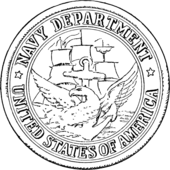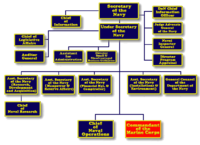
The commandant of the Marine Corps (CMC) is normally the highest-ranking officer in the United States Marine Corps. It is a four-star general position and a member of the Joint Chiefs of Staff. The CMC reports directly to the secretary of the Navy and is responsible for ensuring the organization, policy, plans, and programs for the Marine Corps as well as advising the president, the secretary of defense, the National Security Council, the Homeland Security Council, and the secretary of the Navy on matters involving the Marine Corps. Under the authority of the secretary of the Navy, the CMC designates Marine personnel and resources to the commanders of unified combatant commands. The commandant performs all other functions prescribed in Section 8043 in Title 10 of the United States Code or delegates those duties and responsibilities to other officers in his administration in his name. As with the other joint chiefs, the commandant is an administrative position and has no operational command authority over United States Marine Corps forces.
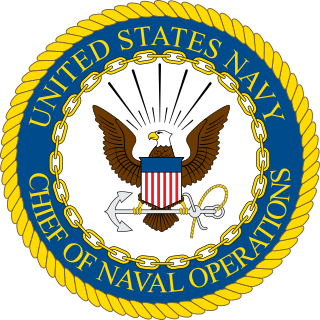
The chief of naval operations (CNO) is the highest-ranking officer of the United States Navy. The position is a statutory office held by an admiral who is a military adviser and deputy to the secretary of the Navy. The CNO is also a member of the Joint Chiefs of Staff and in this capacity, a military adviser to the National Security Council, the Homeland Security Council, the secretary of defense, and the president.

The United States secretary of defense (SecDef) is the head of the United States Department of Defense, the executive department of the U.S. Armed Forces, and is a high-ranking member of the federal cabinet. The secretary of defense's position of command and authority over the military is second only to that of the president of the United States, who is the commander-in-chief. This position corresponds to what is generally known as a defense minister in many other countries. The secretary of defense is appointed by the president with the advice and consent of the Senate, and is by custom a member of the Cabinet and by law a member of the National Security Council.

The secretary of the Navy (SECNAV) is a statutory officer and the head of the Department of the Navy, a military department within the United States Department of Defense.

The National Security Act of 1947 was a law enacting major restructuring of the United States government's military and intelligence agencies following World War II. The majority of the provisions of the act took effect on September 18, 1947, the day after the Senate confirmed James Forrestal as the first secretary of defense.

The United States Department of the Air Force (DAF) is one of the three military departments within the Department of Defense of the United States of America. The Department of the Air Force was formed on September 18, 1947, per the National Security Act of 1947 and it is the military department within which the United States Air Force and the United States Space Force are organized.

The vice chief of naval operations (VCNO) is the second highest-ranking commissioned United States Navy officer in the Department of the Navy and functions as the principal deputy of the chief of naval operations and by statute, the vice chief is appointed as a four-star admiral.

Francis Patrick Matthews was an American who served as the 8th Supreme Knight of the Knights of Columbus from 1939 to 1945, the 50th United States Secretary of the Navy from 1949 to 1951, and United States Ambassador to Ireland from 1951 to 1952.

Paul Francis McHale Jr. is a retired American lawyer and politician as well as a United States Marine. From 2003 to 2009, he served as the Assistant Secretary of Defense for Homeland Defense. From 1993 to 1999, he represented Pennsylvania's 15th congressional district in the United States House of Representatives.
In the United States military, a general is the most senior general-grade officer; it is the highest achievable commissioned officer rank that may be attained in the United States Armed Forces, with exception of the Navy and Coast Guard, which have the equivalent rank of admiral instead. The official and formal insignia of "general" is defined by its four stars.
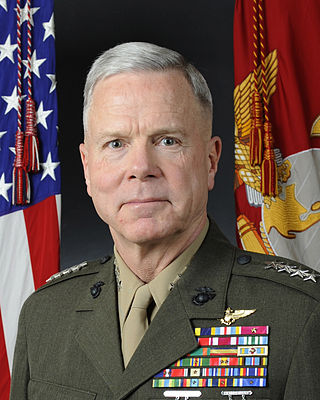
James F. "Jim" Amos is a retired United States Marine Corps four-star general who served as the 35th commandant of the Marine Corps. As a naval aviator, Amos commanded the 3rd Marine Aircraft Wing during the Iraq War in 2003 and 2006. He served as the 31st assistant commandant of the Marine Corps from 2008 to 2010, and was the first Marine Corps aviator to serve as commandant. He retired from the Marine Corps in December 2014.

The United States Department of Defense is an executive branch department of the federal government of the United States charged with coordinating and supervising all agencies and functions of the U.S. government directly related to national security and the United States Armed Forces. As of June 2022, the U.S. Department of Defense is the largest employer in the world, with over 1.34 million active-duty service members, including soldiers, marines, sailors, airmen, and guardians. The Department of Defense also maintains over 778,000 National Guard and reservists, and over 747,000 civilians bringing the total to over 2.87 million employees. Headquartered at the Pentagon in Arlington County, Virginia, just outside Washington, D.C., the Department of Defense's stated mission is to provide "the military forces needed to deter war and ensure our nation's security".
The structure of the United States Navy consists of four main bodies: the Office of the Secretary of the Navy, the Office of the Chief of Naval Operations, the operating forces, and the Shore Establishment.
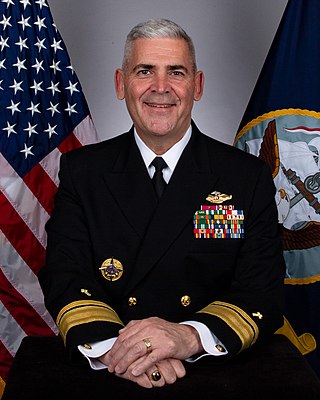
The Chief of Chaplains of the United States Navy (CHC) is the highest-ranking military chaplain in the United States Navy and head of the United States Navy Chaplain Corps. As part of the Office of the Chief of Naval Operations and Department of the Navy, the CHC is dual-hatted as the Director of Religious Ministries (N097) under OPNAV. In these capacities, the CHC is the principal advisor to the secretary of the Navy, the chief of naval operations and, where appropriate, the commandant of the Marine Corps and commandant of the Coast Guard "on all matters pertaining to religion within the Navy, United States Marine Corps, and United States Coast Guard." For administrative and personnel matters, the CHC reports to the chief of naval personnel.

The United States Department of Defense (DoD) has a complex organizational structure. It includes the Army, Navy, the Marine Corps, Air Force, Space Force, the Unified combatant commands, U.S. elements of multinational commands, as well as non-combat agencies such as the Defense Intelligence Agency and the National Security Agency. The DoD's annual budget was roughly US$496.1 billion in 2015. This figure is the base amount and does not include the $64.3 billion spent on "War/Non-War Supplementals". Including those items brings the total to $560.6 billion for 2015.


